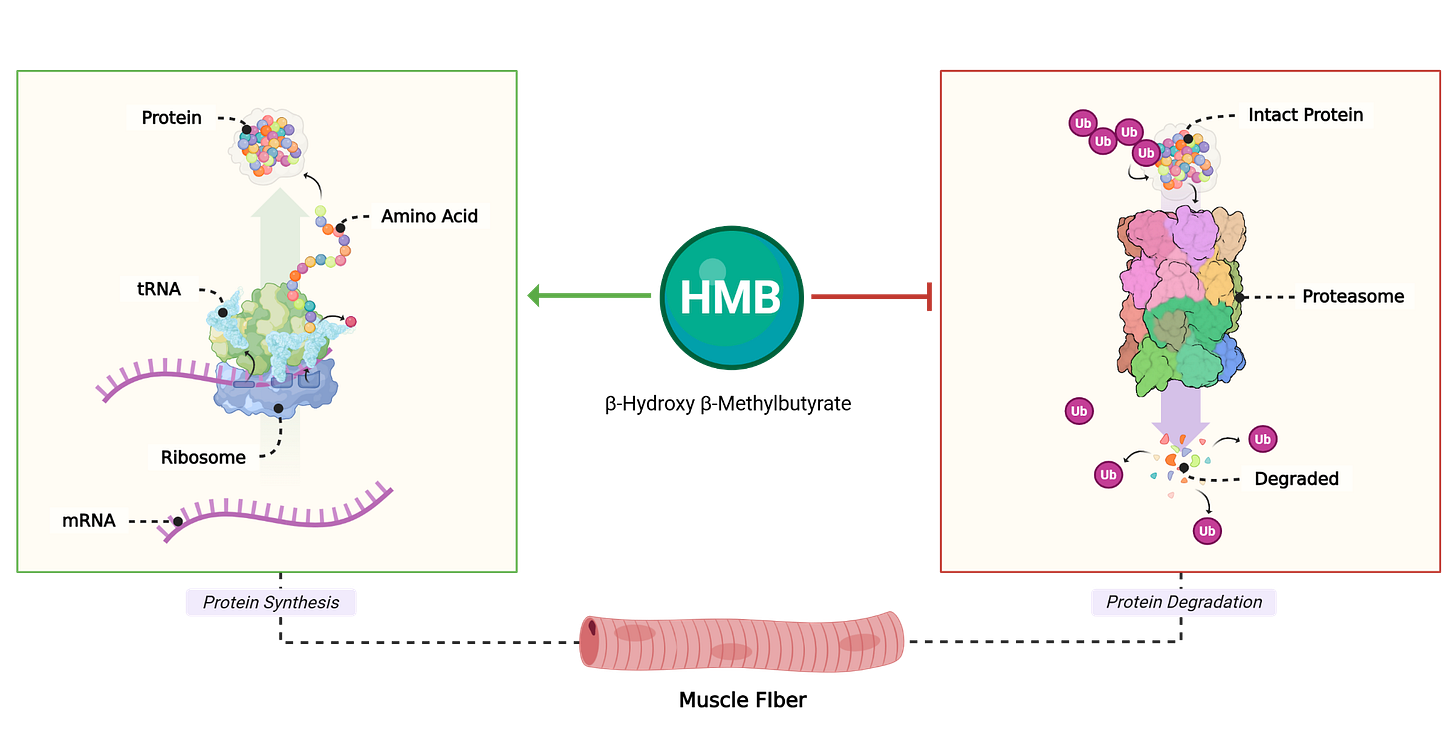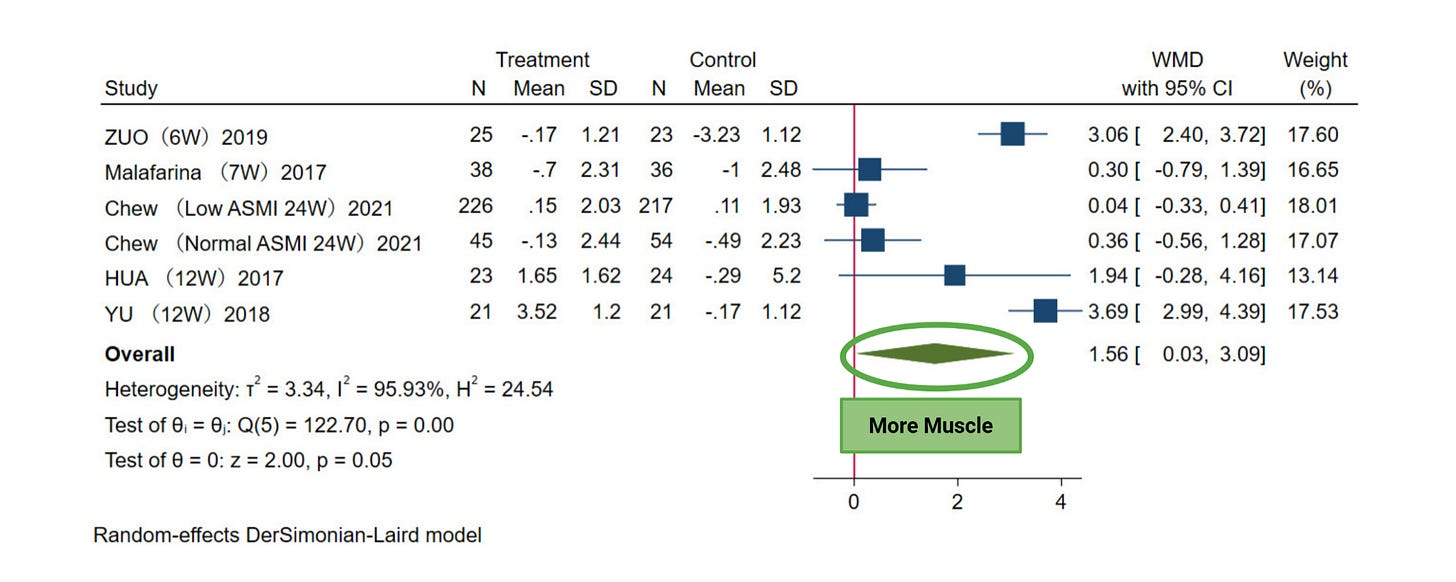HMB: Protecting Against Age-Related Muscle Loss
Main Points
HMB can help older adults (50+) improve muscle size and strength, but the benefit shows up most clearly when you pair ~3 g/day with consistent resistance training; the free-acid form may absorb better than calcium-bound HMB; overall evidence quality is mixed, comparisons against robust protein/leucine strategies are limited, and effect sizes are modest—so treat HMB as a supportive add-on to a well-designed exercise and nutrition plan, not a standalone solution.
HMB—short for β-hydroxy-β-methylbutyrate—has bounced between “miracle” and “meh” in fitness circles. I’m late to the party, but I went through 20+ studies to give you a clear, practical take. I’ll keep it simple, define any jargon, and leave you with concrete guidance.
What HMB Is (and the Basic Idea)
HMB is a compound your body makes from the amino acid leucine. In plain terms, it’s thought to do two main things: reduce muscle protein breakdown (catabolism) and, to a lesser extent, boost muscle protein synthesis (anabolism). “Protein breakdown” means your body is tearing down the proteins inside muscle cells; “protein synthesis” means building them up. If breakdown goes down and synthesis goes up, muscle mass and, potentially, muscle function should improve.
Does HMB Actually Help Older Adults?
Short answer: yes—conditionally. Two large analyses [520-521] pooled randomized controlled trials (the gold-standard study design where people are randomly assigned to HMB or no HMB) and looked specifically at adults 50+. Across these trials, HMB improved muscle size and strength. In other words, when you combine lots of studies, the overall effect lands on the “benefit” side for people over 50.
The Big Condition: Exercise Matters
Here’s the catch. When researchers sliced the data into subgroups (for example, “with exercise” versus “no exercise”), HMB on its own didn’t do much. The consistent signal is that HMB works best when it’s paired with exercise—especially resistance training. If you’re not training, the benefits shrink or disappear.
More analysis on HMB combination supplements and effectiveness without training
Pairing HMB with protein when training
All of that is included in the complete analysis, along with access to a private podcast, live sessions with me, a library of articles and videos, and much more as a Physionic Insider:
Dosing: How Much Is Enough?
Dose matters. The most effective studies typically used around 3 grams per day. Lower doses tended to show weaker or no benefits. If you’re going to try HMB, 3 grams daily is the practical floor.
Calcium HMB vs. Free HMB
Many trials use calcium-bound HMB (Ca-HMB), but some reviews [A] suggest “free acid” HMB (an unbound form) may be absorbed better. In everyday terms: the form might influence how much your body actually uses, and free HMB could have an edge.
Important Caveats (Why I’m Cautious)
Evidence quality is not perfect. The overall quality, as judged by the researchers, is modest to low for some outcomes. That doesn’t mean the results are wrong, but it does mean we should stay humble about the magnitude of the effect.
Publication gaps likely exist. The analyses didn’t pull from ClinicalTrials registries where finished but unpublished trials (including “no effect” studies) still have to report results. That omission can bias the picture toward positive findings.
Comparators weren’t ideal. Most studies compared HMB to placebo or “nothing,” not to high-quality protein or leucine-rich foods/supplements. Since HMB is derived from leucine, it would be ideal to know whether HMB is uniquely better than just getting enough protein or leucine. Some head-to-head work exists, but it’s limited, short, or under-dosed for HMB, and not focused on the older-adult sweet spot.
Effect sizes are modest. Even where HMB helps, we’re not talking about dramatic changes. Think “useful nudge,” not “overnight transformation.”
Practical Take
If you’re 50+ and resistance-train, HMB can be a reasonable add-on, with the best evidence around 3 g/day (and potentially favoring the free-acid form). If you’re not exercising, HMB alone is unlikely to deliver much for muscle size or function. Also remember that we still need better comparisons against high-quality protein strategies to know if HMB offers something unique beyond a solid diet.
Main Points
HMB can help older adults (50+) improve muscle size and strength, but the benefit shows up most clearly when you pair ~3 g/day with consistent resistance training; the free-acid form may absorb better than calcium-bound HMB; overall evidence quality is mixed, comparisons against robust protein/leucine strategies are limited, and effect sizes are modest—so treat HMB as a supportive add-on to a well-designed exercise and nutrition plan, not a standalone solution.
More analysis on HMB combination supplements and effectiveness without training
Pairing HMB with protein when training
All of that is included in the complete analysis, along with access to a private podcast, live sessions with me, a library of articles and videos, and much more as a Physionic Insider :
Dr. Nicolas Verhoeven, PhD / Physionic
References
[Study 520] Li N, Chen S, He Y, Chen Y, Duan X, He W, Wang Q, Liu S, Liu T, Fang H. Effects of oral supplementation of β-hydroxy-β-methylbutyrate on muscle mass and strength in individuals over the age of 50: a meta-analysis. Front Nutr. 2025;12:1522287. doi:10.3389/fnut.2025.1522287.
Funding/Conflicts: Public Funding: Ministry of Science and Technology of the People’s Republic of China (grant 2022YFF1100605); Non-Profit Funding: Chinese Institute of Food Science and Technology (grant 2022-F01); Industry Funding: none reported// Conflicts of Interest: authors state no commercial or financial relationships that could be construed as a potential conflict of interest.
[Study 521] Feng Y, Chen P, Li T, Wan P, Shi R. Effects of exercise with or without β-hydroxy-β-methylbutyrate supplementation on muscle mass, muscle strength, and physical performance in patients with sarcopenia: a systematic review and meta-analysis. Front Nutr. 2024;11:1460133. doi:10.3389/fnut.2024.1460133.
Funding/Conflicts: Public Funding: National Natural Science Foundation of China (32171136); Natural Science Foundation of Shanghai (19ZR1452900); Key R&D Project of the Ministry of Science and Technology (2020YFC2005604); Shanghai Frontiers Science Research Base of Exercise and Metabolic Health; Research and Innovation Grant for Graduate Students, Shanghai University of Sport (YJSCX-2024-021); Non-Profit Funding: none reported; Industry Funding: none reported // Conflicts of Interest: authors declare the research was conducted in the absence of commercial or financial relationships that could be construed as a potential conflict of interest.
[A] Rathmacher JA, Pitchford LM, Stout JR, et al. International society of sports nutrition position stand: β-hydroxy-β-methylbutyrate (HMB). J Int Soc Sports Nutr. 2025;22(1):2434734. doi:10.1080/15502783.2024.2434734



